by Eric Meier
When attempting to identify a wood sample, it’s important to keep in mind the limitations and obstacles that are present in our task. Before starting, please have a look at The Truth Behind Wood Identification to approach the task in a proper mindset; I consider the linked article to be required reading for all those visiting my site with the intent of identifying wood.
1. Confirm it is actually solid wood.
Before proceeding too much farther into the remaining steps, it’s first necessary to confirm that the material in question is actually a solid piece of wood, and not a man-made composite or piece of plastic made to imitate wood.
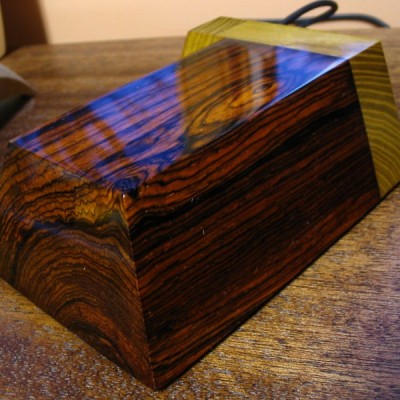
Can you see the end-grain?
Manufactured wood such as MDF, OSB, and particleboard all have a distinct look that is—in nearly all cases—easily distinguishable from the endgrain of real wood. Look for growth rings—formed by the yearly growth of a tree—which will be a dead-giveaway that the wood sample in question is a solid, genuine chunk of wood taken from a tree.
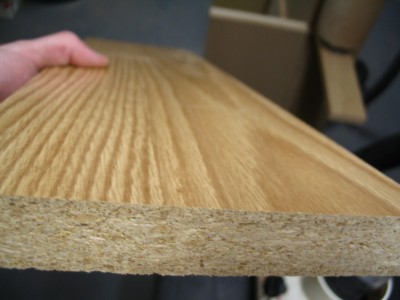
Is it veneered?
If you see a large panel that has a repeating grain pattern, it may be a veneer. In such cases, a very thin layer of real wood is peeled from a tree and attached to a substrate; sometimes the veneer can be one continuous repeating piece because it is rotary-sliced to shave off the veneer layer as the tree trunk is spun by machines. Assuming it is a real wood veneer with a distinct grain and texture—and not merely a piece of printed plastic—you may still be able to identify the outer veneer wood in question, but you should still realize that is it only a veneer and not a solid piece of wood.
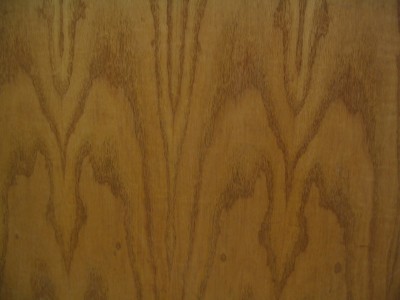
Is it painted or printed to look like wood?
Many times, especially on medium to large-sized flat panels for furniture, a piece of particleboard or MDF is either laminated with a piece of wood-colored plastic, or simply painted to look like wood grain. Many of today’s interior hardwood flooring planks are good examples of these pseudo-wood products: they are essentially a man-made material made of sawdust, glues, resins, and durable plastics.
2. Look at the color.
Some questions to immediately ask yourself:
Is the color of the wood natural, or is it stained?
If there is even a chance that the color isn’t natural, the odds are increased that the entire effort of identifying the wood will be in vain.
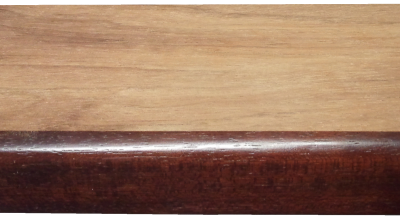
Is it weathered or have a patina?
Many woods, when left outside in the elements, tend to turn a bland gray color. Also, even interior wood also takes on a patina as it ages: some woods get darker, or redder, and some even get lighter or lose their color; but for the most part, wood tends to darken with age.
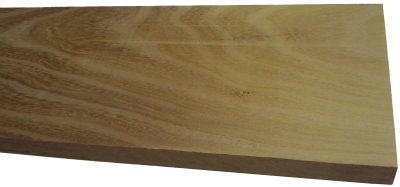
Is it possible to sand or plane the board to see the natural raw color of the wood?
The most predictable baseline to use when identifying wood is in a freshly sanded state. This eliminates the chances of a stain or natural aging skewing the color diagnosis of the wood.
3. Observe the wood grain.
If the wood is unfinished, then look at the texture of the grain. Ask yourself these questions:
Does the wood have an open, porous texture?
Most softwoods will be almost perfectly smooth with no grain indentations, while many common hardwoods have an open pore structure, such as oak or mahogany; though there are some hardwoods that are also smooth to the touch, such as maple.
Can you tell if the wood is quartersawn or plainsawn?
By observing the grain patterns, many times you can tell how the board was cut from the tree. Some wood species have dramatically different grain patterns from plainsawn to quartersawn surfaces. For instance, on their quartersawn surfaces, lacewood has large lace patterns, oak has flecks, and maple has the characteristic “butcher block” appearance.
Is there any figure or unusual characteristics, such as sapwood, curly or wild grain, burl/knots, etc.?
Some species of wood have figure that is much more common than in other species: for example, curly figure is fairly common in soft maple, and the curls are usually well-pronounced and close together. Yet when birch or cherry has a curly grain, it is more often much less pronounced, and the curls are spaced farther apart.
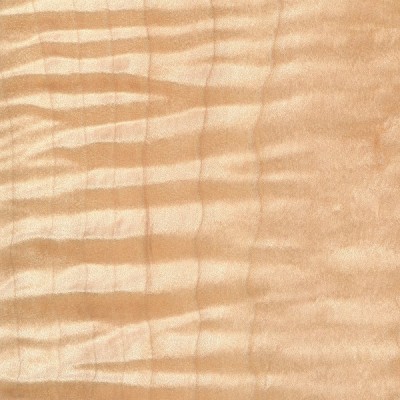
4. Consider the weight and hardness of the wood.
If it’s possible, pick the piece of wood up and get a sense of its weight, and compare it to other known wood species. Try gouging the edge with your fingernail to get a sense of its hardness. If you have a scale, you can take measurements of the length, width, and thickness of the wood, and combine them to find the density of the wood. This can be helpful to compare to other density readings found in the database. When examining the wood in question, compare it to other known wood species, and ask yourself these questions:
Is the wood dry?
Wood from freshly felled trees, or wood that has been stored in an extremely humid environment will have very high moisture contents. In some freshly sawn pieces, moisture could account for over half of the wood’s total weight! Likewise, wood that has been stored in extremely dry conditions of less than 25% relative humidity will most likely feel lighter than average.
How does the wood’s weight compare to other species?
Taking into account the size of the board, how does its weight compare to other benchmark woods? Is it heavier than oak? Is it lighter than pine? Look at the weight numbers for a few wood species that are close to yours, and get a ballpark estimate of its weight.
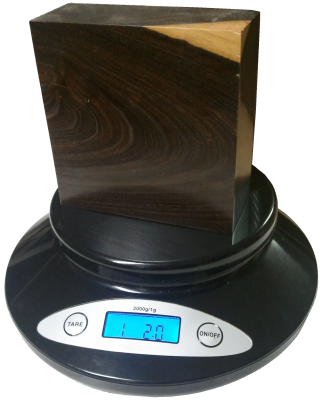
How hard is the wood?
Obviously softwoods will tend to be softer than hardwoods, but try to get a sense of how it compares to other known woods. Density and hardness are closely related, so if the wood is heavy, it will most likely be hard too. If the wood is a part of a finished item that you can’t adequately weigh, you might be able to test the hardness by gouging it in an inconspicuous area. Also, if it is used in a piece of furniture, such as a tabletop, a general idea of its hardness can be assessed by the number and depth of the gouges/dings in the piece given its age and use. A tabletop made of pine will have much deeper dents than a tabletop made of Oak. Additionally, you can always try the “fingernail test” as a rough hardness indicator: find a crisp edge of the wood, and with your fingernail try to push in as hard as you can and see if you’re able to make a dent in the wood.
5. Consider its history.
Many times we forget common sense and logic when attempting to identify wood. If you’ve got a piece of Amish furniture from Pennsylvania, chances are more likely that the wood will be made of something like black walnut or cherry, and not African wenge or jatoba. You might call it “wood profiling,” but sometimes it can pay to be a little prejudiced when it comes to wood identification. Some common-sense questions to ask yourself when trying to identify a piece of wood:
Where did it come from?
Knowing as much as you can about the source of the wood—even the smallest details—can be helpful. If the wood came from a wood pile or a lumber mill where all the pieces were from trees processed locally, then the potential species are immediately limited. If the wood came from a builder of antique furniture, or a boat-builder, or a trim carpenter: each of these occupations will tend to use certain species of woods much more often than others, making a logical guess much simpler.
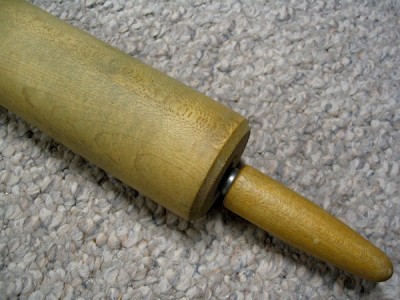
How old is it?
As with the wood’s source, its age will also help in identification purposes. Not only will it help to determine if the wood should have developed a natural patina, but it will also suggest certain species which were more prevalent at different times in history. For instance, many acoustic guitars made before the 1990s have featured Brazilian rosewood backs/sides, yet due to CITES restrictions placed upon that species, East Indian rosewood became a much more common species on newer guitars. (And this is a continuing shift as newer replacements are sought for rosewoods altogether.)
How large is the piece of wood?
Some species of trees are typically very small—some are even considered shrubs—while others get quite large. For instance, if you see a large panel or section of wood that’s entirely black, chances are it’s either painted, dyed, or stained: Gaboon ebony and related species are typically very small and very expensive.
What is the wood’s intended use?
Simply knowing what the wood was intended for—when considered in conjunction with where it came from and how old it is—can give you many clues to help identify it. In some applications, certain wood species are used much more frequently than others, so that you can make an educated guess as to the species of the wood based upon the application where it was used. For instance, in the United States: many older houses with solid hardwood floors have commonly used either red oak or hard maple; many antique furniture pieces have featured quartersawn white oak; many violins have spruce tops; many closet items used aromatic red cedar, and so forth. While it’s not a 100% guarantee, “profiling” the wood in question will help reduce the number of possible suspects, and aid in deducing the correct species.
6. Find the X-Factor.
Sometimes, after all the normal characteristics of a sample have been considered, the identity of the wood in question is still not apparent. In these instances—particularly in situations where a sample has been narrowed down to only a few possible remaining choices—it’s sometimes helpful to bring in specialized tests and other narrower means of identification.
The following techniques and recommendations don’t necessarily have a wide application in initially sorting out wood species and eliminating large swaths of wood species, but will most likely be of use only as a final step in special identification circumstances.
Odor
Believe it or not, freshly machined wood can have a very identifiable scent. When your eyes and hands can’t quite get a definitive answer, sometimes your nose can. Assuming there is no stain, finish, or preservative on or in the wood, quickly sand, saw, or otherwise machine a section of the wood in question, and take a whiff of the aroma.
Although new scents can be very difficult to express in words, many times the scent of an unknown wood may be similar to other known scents. For instance, rosewoods (Dalbergia spp.) are so named for their characteristic odor that is reminiscent of roses. Although difficult to directly communicate, with enough firsthand experience scents can become a memorable and powerful means of wood identification.
Fluorescence
While certain woods can appear basically identical to one another under normal lighting conditions, when exposed to certain wavelengths—such as those found in blacklights—the wood will absorb and emit light in a different (visible) wavelength. This phenomenon is known as fluorescence, and certain woods can be distinguished by the presence or absence of their fluorescent qualities. See the article Fluorescence: A Secret Weapon in Wood Identification for more information.
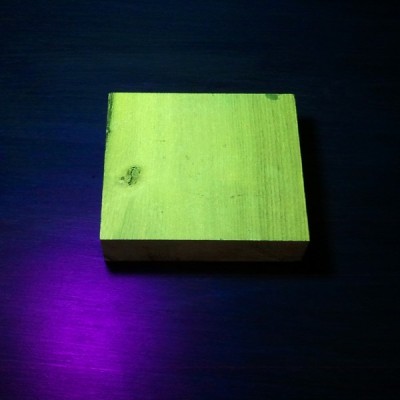
Chemical Testing
There are only a small number of chemical tests regularly used on wood, most of which are very specialized and were developed to help distinguish easily confused species with one another. They work by detecting differences in the composition of heartwood extractives. A chemical substance (called a reagent) is usually dissolved in water and applied to the wood surface: the surface is then observed for any type of chemical reaction (and accompanying color change) that may occur. Two of the most useful are the tests that are meant to separate Red and White Oak, and Red and Hard Maple.
Heartwood Extractives Leachability
Sometimes a wood species will have heartwood extractives that will be readily leachable in water and capable of conspicuously tinting a solution of water a specific color. For instance, the heartwood extractives contained in osage orange (Maclura pomifera) contain a yellowish-brown dye that is soluble in water. (This can sometimes be observed anecdotally when the wood is glued with a water-based adhesive: the glue’s squeeze-out is an unusually vibrant yellow.)
In a simple water extract color test, wood shavings are mixed with water in a vial, test tube, or other suitably small container, and the color of the water is observed after a few minutes. If the heartwood extractives are leachable by water, then a corresponding color change should quickly occur.
In addition to osage orange (Maclura pomifera), merbau (Intsia spp.), and rengas (Gluta spp. and Melanorrhoea spp.) are also noted for their readily leachable heartwood extractives. Because this property is quite uncommon, it can serve to quickly differentiate these woods from other lookalikes.
7. Look at the endgrain.
Perhaps no other technique for accurate identification of wood is as helpful and conclusive as the magnified examination of the endgrain. Frequently, it brings the identification process from a mostly intuitive, unscientific process into a predictable, repeatable, and reliable procedure.
Looking at the endgrain with a magnifier shouldn’t be a mystifying or esoteric art. In many cases, it’s nearly as simple as examining small newsprint under a magnifying glass. There are three components necessary to reap the full benefits contained in the endgrain:
I. A prepared surface.
When working with wood in most capacities, it becomes quickly apparent that endgrain surfaces are not nearly as cooperative or as easily worked as face grain surfaces. However, in this case, it is absolutely critical that a clear and refined endgrain surface is obtained.
For a quick glance of a softwood sample, a very sharp knife or razor blade can be used to take a fresh slice from the endgrain. However, in many denser species, especially in tropical hardwoods, one of the best ways to obtain a clear endgrain view is through diligent sanding. It’s usually best to begin with a relatively smooth saw cut (as from a fine-toothed miter saw blade) and proceed through the grits, starting at around 100, and working up to at least 220 or 320 grit, preferably higher for the cleanest view.
II. The right magnifier.
It need not be expensive, but whatever tool is used to view the endgrain should have adequate magnifying power. In most instances, 10x magnification is ideal, however, anything within the range of 8 to 15x magnification should be suitable for endgrain viewing. (Standard magnifying glasses are typically in the range of 2 to 4x magnification.)
These stronger magnifiers, sometimes called loupes, usually have a smaller viewing area than standard magnifying glasses. Fancier models—with built in lights, or larger viewing surfaces—are available at a premium; but the most basic models are usually only a few dollars.
III. A trained eye.
The third element that constitutes a proper endgrain examination is simply knowing what to look for. In analyzing the patterns, colors, shapes, and spacing of the various anatomical features, there is a veritable storehouse of information within the endgrain—all waiting to be unlocked. Yet, if these elements have not been pointed out and learned, the array of features will simply seem like an unintelligible jumble. The discipline of recognizing anatomical endgrain features is not easily summed up in a few sentences or even a few paragraphs, but it is nonetheless critical to the identification process. To this end, an in-depth look should be given to the various categories, divisions, and elements that constitute endgrain wood identification on the macroscopic level. (In this regard, macroscopic denotes what can be seen with a low-powered, 10x hand lens—without the aid of a microscope—rather than simply what can be seen with the naked eye.) Because the anatomy between softwoods and hardwoods is so divergent, each will be considered and examined separately:Still stumped?
If you have a mysterious piece of wood that you’d like identified, you’ve got a few options for next steps:USDA’s Forest Products Laboratory
You can mail your physical wood samples to the Center for Wood Anatomy Research.
Pros:
- Free
- Professional wood identification
Cons:
- Only available to US citizens
- Slow turnaround times (up to a month or more)
- Limited to three IDs per year
See their Wood ID Factsheet for more info.
Alden Identification Service
You can mail your physical wood samples (even small sections taken from antiques) to Alden Identification Service.
Pros:
- Professional wood identification
- Faster turnaround times (ranging from a few days to a week or two)
Cons:
- Paid service
See their ordering page for more info. (Note that Harry Alden has written several books while at USDA, including both Hardwoods and Softwoods of North America.)
Ask for help online
If the wood ID is merely a curiosity, or non-critical, you can post pictures of the wood in question.
Pros:
- Free
- No need to send physical samples
Cons:
- Greatly limited by the quality of the pictures provided
- Extra work usually required to get adequate clarity in photos
See article of Common US Hardwoods to help find the most commonly used woods.
Get the hard copy
 If you’re interested in getting all that makes The Wood Database unique distilled into a single, real-world resource, there’s the book that’s based on the website—the Amazon.com best-seller, WOOD! Identifying and Using Hundreds of Woods Worldwide. It contains many of the most popular articles found on this website, as well as hundreds of wood profiles—laid out with the same clarity and convenience of the website—packaged in a shop-friendly hardcover book.
If you’re interested in getting all that makes The Wood Database unique distilled into a single, real-world resource, there’s the book that’s based on the website—the Amazon.com best-seller, WOOD! Identifying and Using Hundreds of Woods Worldwide. It contains many of the most popular articles found on this website, as well as hundreds of wood profiles—laid out with the same clarity and convenience of the website—packaged in a shop-friendly hardcover book. 





Why I will no longer be replying to every wood ID request I’ve replied to literally thousands of wood ID requests on this site over the past 13+ years, but as the site’s popularity has grown, so has the time demands for ID on a daily basis. (Contrary to what some may seem to think, I am not some all-knowing wood wizard that can instantly ID your wood. It can actually take me a long time to sift through a lot of different resources.) Over the past few years, my backlog of pending wood species to be added to the… Read more »
Any ideas please?
Hi. Thank you so much, this website is really helpful. There’s a refurbished chest of drawers I wish to purchase but the seller has no clue about the wood, she has shared some pics though. The last pic is the back of the dressing table mirror (separate piece which has been matched to the chest of drawers) Can i please have any info on what sort of wood might have been used. Many thanks in advance. Zain (UK)
Can’t tell conclusively from those pics, but at the very least, it looks mahogany-like.
Thank you so much Eric. The mirror (last pic) I was told might be mahogany but the seller was not sure about the drawers. So, will it be okay to assume that the drawers too are made of some good quality hard wood. Thanks, Zain
Wondering if someone could identify this wood.
I can’t tell from the pic, carvings are very hard, sorry.
Hi again,
and this one as well?
Hi Eric,
I’m planning to make a few small sculpture with these woods. Could you tell me what is these?
Thanks.
The endgrain is too rough to make out any details for ID. Possibly a type of mahogany?
Anyone? I received this lumber from my grandfather who has sense passed away andI believe he intended to use for trim on a old wooden boat that he was fixing up but I’m not positive. I used some of it to build my grandmother a raised planter for vegetables. I have been around woodworking my entire life and have worked with dozens of different species of wood throughout the years but nothing even close to as hard as this particular wood. Especially when it came to sanding it! I spent hours upon hours sanding it with every sander I own.… Read more »
Please attach pics.
I have a pile of lumber that was taken out of a building built in Dallas Texas back in the 1920’s-1940’s. I am thinking it is old growth pine but was hoping for more clarification. Also seen in the pictures are a home depot SYP 2×4 and a 6×6 from the same old buildings that I am not sure of the species either. The 6×6 had a distinct odor when cutting and planing while the piece of the 2×16 joist (cut much smaller to joint and plane) had no smell. both dent easily with a fingernail. I was thinking old… Read more »
The first picture is old growth SYP as stated. I can see the resin canals occurring near the growth rings. I can’t see enough detail on the rest of them for ID.
Thanks! In your opinion do you think it’s the “long leaf pine”? And I’ll get a closer shot of the 6×6 and submit that for your review too
There’s no way I can ID pine like this down to a species level.
Here are a few more pictures of the other wood from the first set of pictures… This wood is very light weight and definitely has a strong cedar like smell when cutting…. I would swear its cedar but is not red
It is probably a cedar–there are a handful of species that are lighter in color. I’d say based on age of wood and your location, most likely candidate would be incense cedar.
a few close ups, hope this helps
It looks like ash stained a golden brown to me. Very similar to oak, but I don’t see any rays in the wood, so probably ash.
I am trying to identify the wood and the finish for this handrail from victorian era. Thank you!
Oak?
I can’t tell from that distance. The color looks like typical stained oak, but I can’t say that the grain patterns match, so I remain suspicious. Need a closer pic.
I made this bowl for a friends birthday present and wanted to tell her the species, I bought a job lot of bowl blanks some years back with a variety of species in. The heartwood had a greenish tinge to it before I turned it. It’s quite light wood and scratches easily, as you can see in the close up. I thought I’d sanded it alright but as you can see it could do with some more work. Could it be Bald Cypress? or Yellow buckeye? Or maybe something else entirely? I live in the UK, but I don’t know… Read more »
It looks like that wood is in the nebulous category of lightweight, diffuse porous hardwoods with small to medium pores. So possibilities would include many Populus species (apsen/cottonwood), as well as Magnolia species and willow (Salix spp.). Buckeye is also another possibility, though since you are from the UK, I’d say the closely related horse chestnut would be more likely.
Thank you very much Eric, very helpful. I’m going to spend some time learning more about looking at end grain. I’ve ordered a 10x loupe. All the best, Mr Ward
Hello, I recently purchased a second hand table online that I am stripping the paint off. Any ideas of what type of wood this is? Thank you!
That’s quartersawn white oak, commonly used in antiques. Glad to see it being uncovered!
Great info – Thank you for this! I’m still stumped on this piece, hoping these pics come through clearly and you might know…I believe it’s Bubinga, but just my best guess based on online photos and density. I’d appreciate your opinion. It came with our house 17 years ago, alongside a great piece of Purpleheart. Never knew what to do with it, then recently decided to make a relief sign for a friend. It’s dense, carveable with gouges, albeit somewhat difficult and can chip (not the best choice for my first attempt at signmaking!). Calculated cubic ft weight of this… Read more »
Doug, I agree that it looks like a Guibourtia species, but I don’t think bubinga is the closest match. Maybe it is just the colors from the camera, but to me, it looks closer to ovangkol, which is another closely related species. https://www.wood-database.com/ovangkol/
Thank you, Eric – very much appreciate your time!
Picked up on the Isle of Wight just came down.
Hi Eric, any ideas what this wood is please.
I can’t tell anything from that picture, sorry.
Hi Eric. Do you know what wood this is? All from the same desk. Many thanks for taking a look.
Looks like oak.
Hi Eric!
Do you know what type of wood?
No, sorry.
Do you know what type of wood this table is made of?
I can’t tell from the pic, sorry.
Maybe from this picture. This is the table top side.
Love the site and fellow woodworker here. Noticed you replying to all these comments and decided to jump on the band wagon for this $30 bench I bought at a auction. I have always wondered on what it’s made from. Thanks for your time!
Can’t tell for sure. Looks like a lot of sapwood and only a little bit of heartwood. Something tropical, definitely not domestic, which makes ID a lot harder without knowing where it came from.
Hi, any chance you recognize this type of wood.
Any idea what this wood is
Trying to identify this stained trim without tearing it off the wall. Home is from 1920. Any ideas?
Ive been told maybe maple, cherry, mahogany… Ive tried to I.D. myself but cant seem to find a good match.
Here is another pic of it
Hi, any ideas on what wood this is?
Thanks
Dean.
Id look up pictures of cypress to see if that matches.
Not too sure what type this is? Any ideas?
Any ideas on what this door is? It was painted black and I stripped it and sanded it, still working on the crevices.
It’s a softwood of some sort, possibly pine or fir.
Hello,
I believe this is a pine – do you know what type of pine it is? In the middle of restoring 1925 flooring located in Indiana.
Thank you very much!
More than likely it is a species grouping of hard pines known collectively as southern yellow pine, or sometimes antique heart pine in older applications.
Hola!
Me ayudarías a identificar esta madera, me parece madera dura, voy a elaborar unos anillos y me gustaría saber que tipo de madera es.
Es bastante rojiza!
Me indicas si se ven las fotografías!
Sorry, pic didn’t come through.
Listo!
Hey there, any ideas on this? Sawed in florida
Can’t tell from the picture, parts of the base of the tree look spalted or partially decayed. The little ray fleck that I can see looks closest to maple to me, but not 100% sure. Maple can have a darker streaked heartwood like that too.
I am trying to make some repairs to an old secretary desk and am having trouble identifying this wood. I think it might be cherry or walnut. Thanks
Looks like walnut.
Can you help me identify this wood. I want to make a lid for this box and not sure what kind of wood to buy . Thanks so much for your help.
Loved your article, I attempted to apply each step to determine why kind of wood this 4 poster bed is made from, but I am stumped. Perhaps you can help? I took pictures of the headboard, the post, and the last picture is of the side of the platform frame….
Mahalo from Hawaii
Hi, Can you tell what type of wood? I bought these while in Sicily.
Please could you identify this wood for me.
Thank you
what type of wood is this
Does anyone know what wood this is maybe? Its very heavy
Hi Eric, I’m so happy to have found your page. I sell vintage and antiques via Etsy. I find wooden treasures quite often, but never know who to properly identify what wood it is made of. I really do not like to list items for sale into my shop with all the facts. Could you please tell me what wood this could be? It looks of good quality. The grain is very close to one another and fine (sorry don’t know what wood lingo to use here). It’s completely solid, hand-carved, and looks to be lightly stained. Thank you so… Read more »
I don’t know. It is probably a wood that is regionally common, but not known well internationally. Many such carvings are brought back as souvenirs and are made from relatively obscure local woods.
Wood floor in my new house. I’m guessing pine since I was able to gouge it with my finger (with a good bit of pressure), and it’s a bit chewed up in the doorways. On the other hand, it has no knots and the pattern looks more like red oak. Any thoughts? It was put in a long long time ago (100 or so years ago).
Yes, it looks like red oak.
Are you able to determine the type of wood used on this armoire or wardrobe? I have no idea of the age; the entire piece is amazingly light. I am trying to sell the piece but have no idea of the wood type for description. . Note: the piece is darker in color, though one photo appears lighter from the lighting situation. The last photo, with grain running vertically, is an unfinished interior piece. Thank you in advance for your assistance.
The last photo looks like it could be yellow poplar, but that’s a very tentative guess. I can’t tell too much from those pics. Sorry.
Hi could you possibly identify the this piece of wood? Thanks!
I can’t tell from those pics, sorry.
Hi could you possibly identify the wood used for these chess pieces? Many thanks!!
I can’t tell for sure from the pictures, but possibly boxwood or a satinwood species for the lighter colored piece. Rosewood could be a possibility for the darker pieces, but that’s just a guess.
Great thank you so much
Could you possibly tell me what wood this guitar is made of? The neck looks and feels like a mahogany guitar I own, but the back and sides are foreign to me. Thanks!
Possibly black walnut? Can’t tell for sure from the pic.
Thank you for answering. Here’s a pic of the unfinished interior. Sorry I couldn’t get a better shot (not much light to work with in there).
Looks like walnut to me.
Thank you! It was unfamiliar to me, and walnut is certainly not one I’m accustomed to seeing. Appreciate the help.
Antique corner cabinet. Name that wood! Thanks
The ray fleck reminds me of quartersawn white oak, but I can’t quite tell for sure from that pic.
Two more pics
I can’t tell from those pics, sorry.
Thanks for trying :-)
Derrin, GREAT FIND!! If you plan on refurbishing, I would love to see the results.
Is there any way to tell what kind of wood these chairs are?
I can’t tell from the pictures, sorry.
Trying to decide whether to strip these chairs ….or not….and no idea what they might be made of. They look a bit Danish. The wood revealed by the worn away paint looks so nice-but noone I ask ventures a guess as to what it might be. Would be so grateful for an opinion!
Please attach pics.
Here they are-sorry, thought I had done that….
I can’t tell from the pics, but it looks to be a hardwood with large pores. I would suggest if you are curious to try using a chemical stripper on just one of the chairs to get an idea of how much work involved and get a better idea of wood type.
Wondering what type of wood a very heavy French country dining room table is made from.
Can anyone help with this? Moved into a new home and trying to ID the floor wood. Its all the same continuous floor but the colour changes a lot depending on light and traffic.
Looks like oak
Heart pine or red oak? It has red oak stain on it.
That is heart pine.
I certainly loved reading the information on this site, I still like to have a hard copy of the book.tks for posting this valuable information.
Could you please identify this wood. People are saying it’s ash, but I think it’s more a variety of Walnut.
Assuming that’s a natural wood color, it certainly seems closer to walnut than ash.
Wondering if anyone can help me out with this one? This was hand made by Grandpa in the early 60’s. It heavy like oak , I just never seen oak grain like this before.
Yes, that looks like oak. The grain looks different because it’s quartersawn rather than plain sawn.
Hi Eric, I think I lost the thread somehow. I was trying to identify this wood I am hoping to use in instrument building. I need similar features to the Mahogany and Queensland Maple. Strong stable timber. The timber has been stored outside but under cover for 20+ years. Origin is unknown but it came from a heavy machine packing so it may not be all that uncommon. There is no noticeable scent when working the timber. The sample I photographed is somewhat bleached but most of the timber is a pale red when sawn. I have some really nice… Read more »
Origin is almost never completely unknown, you just have to make educated guesses to help narrow things down. For exampe, you mentioned Queensland maple, so I’m going to assume you are in Australia (which greatly affects possible choices), so more than likely it is of Asian origin. Based on pictures and other info, my best guess would be something in the Dipterocarpaceae family — so maybe a Shorea species such as a type of meranti. But this is all very tentative.
Thanks Eric, Yes you are correct I’m from Australia. Following your lead I’ve done some research and Meranti seems to be the best match overall. This is good news as it seems it is perfect for the application I’m working on. Thank you once again.